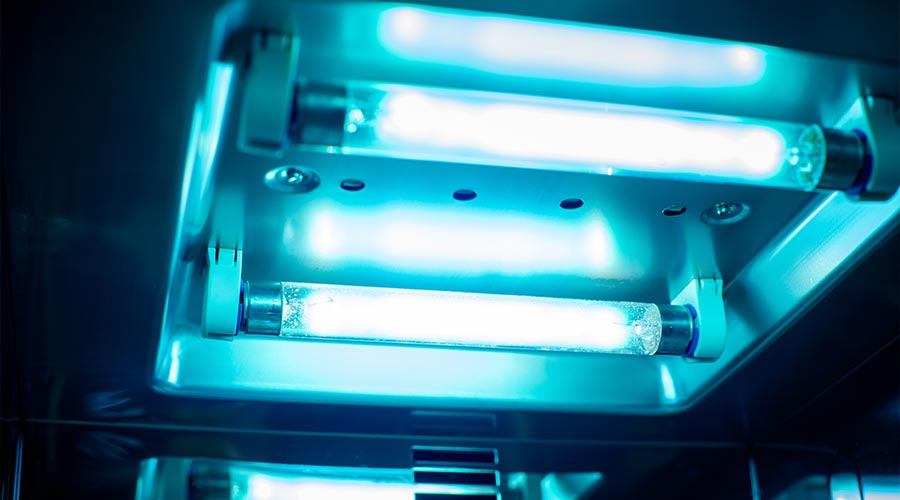
The scrutiny surrounding infection prevention and the quality of cleaning inside facilities is at an all-time high. In healthcare settings, the pressure grows even more — the lives of facility occupants literally hang in the balance. To ensure patient rooms are properly cleaned and disinfected, some facility executives are looking to technology and an investment in ultraviolet-C (UVC) lights.
UVC, according to the Merriam-Webster dictionary, is "radiation that is in the region of the ultraviolet spectrum which extends from about 200 to 280 nm in wavelength, and that is more hazardous than UVB, but is mostly absorbed by earth's upper atmosphere."
These UVC rays are part of the energy generated by the sun. In the form of light technology, UVC can be used to neutralize microorganisms, which is why many healthcare settings find the lights beneficial. They are often used in the form of lamps to augment existing cleaning and disinfecting processes.
Experts are quick to support that fact — UVC technology does not replace the need for traditional cleaning and disinfecting programs. Instead, this equipment supplements existing infection prevention methods.
"It has to be clarified that UVC is never a replacement for manual cleaning and disinfection," says Scott Hedding, MBA, FACHE, vice president environmental and linen services at MedStar Health, Columbia, Maryland. "The systems we utilize are adjuncts to our 'traditional options.' It has been widely proven that UVC kills pathogens on surfaces, so this is an added level of assurance that our spaces are safe and healthy."
Hedding first became familiar with UVC in 2015 when he outfitted his team with the light technology. He was working with another healthcare group at the time, but he successfully worked on a team that identified the technology as a solution to infection prevention demands.
"It was for a 14-hospital system," he recalls. "Environmental Services (EVS) had an active value analysis team that included leadership from Supply Chain, and we brought in Infection Prevention to make the best selection for that system."
The infection prevention successes Hedding experienced in that healthcare system mirrors what he and his team experience today. MedStar Health currently employs 29 UVC systems across 10 hospitals.
To learn more about UVC technology and how it can be used in healthcare facilities, Facility Cleaning Decisions reached out to Hedding to get his perspective. Here are his thoughts.
Zudonyi: In what areas of the facilities are these UVC machines primarily used, and how often?
Hedding: We use UVC in our operating rooms, areas with highly immunocompromised patients, and for specific terminal isolation cleaning areas. We also use UVC in patient and public restrooms. All our devices run daily.
Zudonyi: What training is required for frontline staff before they can use this UVC equipment?
Hedding: Associates must be trained to competence following all manufacturer recommendations. Our vendor is very involved with our EVS teams and is routinely onsite offering updated training.
Zudonyi: What manual/traditional cleaning steps are necessary before/after UVC machines are used?
Hedding: Our EVS team performs the same manual cleaning and disinfection regardless of whether UVC technology is used. As mentioned earlier, this technology is not a replacement for traditional cleaning and disinfection.
Zudonyi: How effective has the UVC light technology been at improving disinfection?
Hedding: The device we use achieves a 99.9999 percent disinfection (6-log reduction), which is in accordance with Food and Drug Administration (FDA) requirements.
Zudonyi: Are there any safety concerns surrounding this technology, specifically for workers or hospital occupants?
Hedding: All the work our EVS team performs comes with a level of safety concern — we clean floors, use chemicals and move equipment around daily. UVC has unique concerns around unintended exposure, but with our training, communication, and the devices’ built-in safety controls, we avoid incidents.
Zudonyi: Is your UVC use part of a bigger sustainability initiative, or are its environmental attributes just an added perk?
Hedding: It is definitely part of our sustainability initiatives. We are continuously looking for better, safer, and more sustainable methods to improve cleaning and disinfection, while maintaining our high standards for infection prevention.
Zudonyi: What suggestions would you offer other executives considering incorporating this technology into their programs?
Hedding: I only suggest following your organization value analysis protocols to find out which, if any, UVC system best meets your needs.
Corinne Zudonyi is the Editor-in-Chief of Facility Cleaning Decisions magazine, Sanitary Maintenance magazine, Contracting Profits magazine and CleanLink.com.

 Celebrating BSCAI's 60th Anniversary eBook
Celebrating BSCAI's 60th Anniversary eBook The Down and Dirty on Cleaning in Virus Season
The Down and Dirty on Cleaning in Virus Season How Surfactant Use is Expanding in Commercial Cleaning
How Surfactant Use is Expanding in Commercial Cleaning